Playdough Recipe Variations: Exploring Different Textures
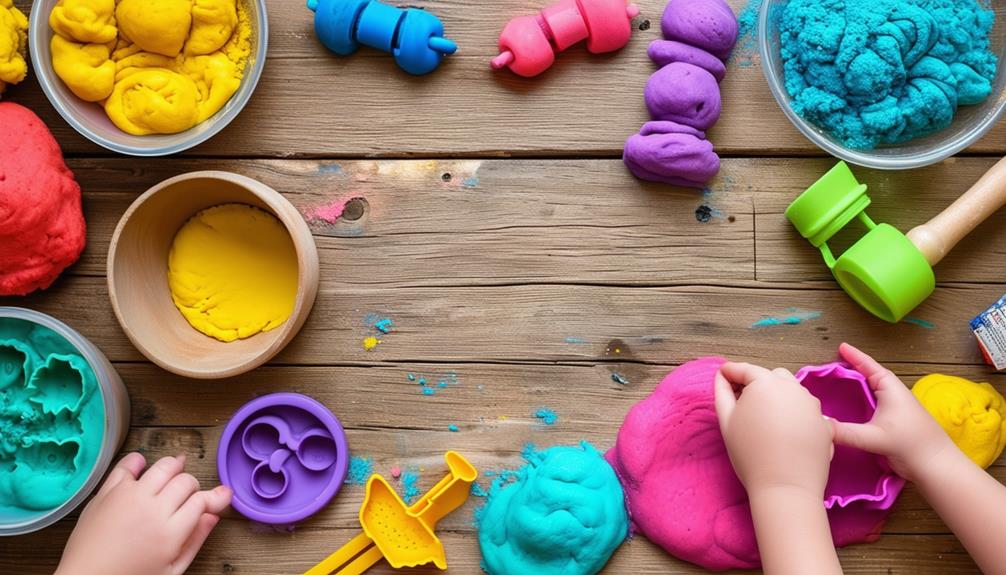
When you think about playdough, the standard recipe may come to mind, but have you ever considered the variety of textures you can create? From the silky smoothness of lotion-based dough to the gritty feel of sand-infused dough, each variation offers a unique sensory experience. Imagine the delight in a child's eyes when they discover the salt-speckled dough or the aromatic bliss of essential oil-infused playdough. These textures do more than entertain—they enhance fine motor skills and cognitive development. How do you choose which texture suits your child's needs best? Let's explore the possibilities.
Silky Soft Play Dough
Creating silky soft play dough is simple and requires just two ingredients for a smooth, stretchy texture. By using lotion instead of conditioner, you'll create a luxurious feel that's perfect for sensory play. Start by combining lotion with cornstarch. Mix them until you get a dough that's easy to mold and shape. This play dough is a hit with kids because it's fun to play with and engages their senses.
As children mold and shape the silky soft play dough, they refine their fine motor skills. The smooth texture makes it an ideal medium for sensory exploration, offering tactile stimulation that's both calming and enjoyable. This play dough encourages creativity and imaginative play, allowing kids to express themselves through diverse creations, from simple shapes to intricate designs, all while benefiting from the sensory experience.
Incorporating this play dough into your routine provides children with a soothing and productive activity. It's a perfect example of how play dough recipes can be both enjoyable and beneficial. So, grab those two ingredients and start creating a world of sensory delight!
Salt Speckled Play Dough
Salt speckled play dough introduces a delightful texture to playtime by incorporating rough sea salt, providing a unique sensory experience for children. As kids mold the play dough, they'll encounter the gritty texture of the salt, which is both captivating and beneficial for their fine motor skills. This version of play dough offers a sensory-rich activity that promotes exploration and creativity.
Introducing salt speckled play dough into sensory play allows children to discover different textures in a playful setting. The rough sea salt mixed into the dough creates a distinct tactile experience, intriguing children as they press, roll, and shape it. This type of play not only enhances their sensory awareness but also supports fine motor development.
To make salt speckled play dough, simply add rough sea salt to your regular play dough recipe. The salt will be visually and texturally prominent, making the dough more engaging to work with. It's an easy and fun way to enhance the sensory play experience. Prepare to see your kids revel in the new textures and sensations!
Rough Sand Play Dough
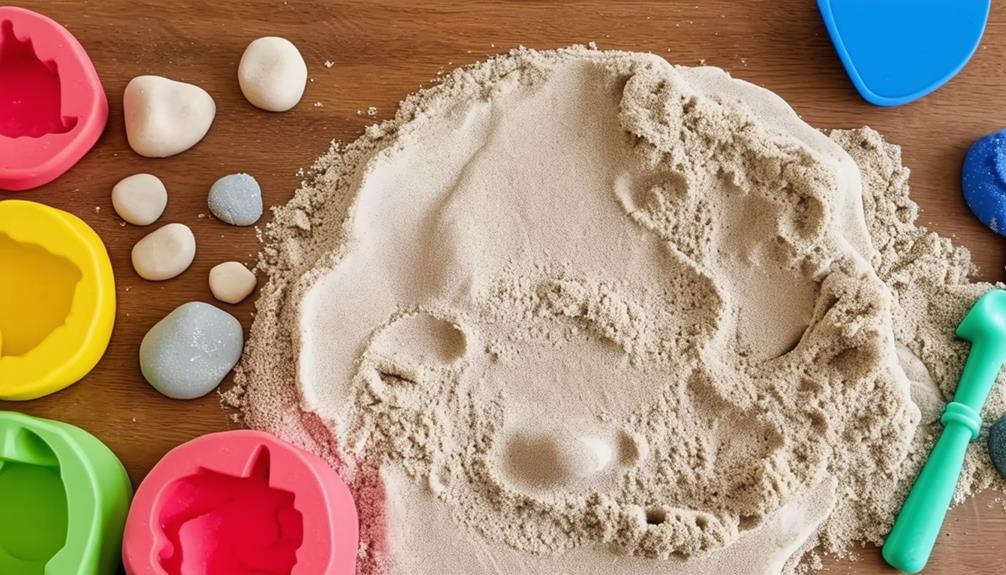
A favorite among children, rough sand play dough offers a gritty texture ideal for sensory exploration. This variation engages kids in tactile experiences, making playtime both enjoyable and educational. The inclusion of sand creates a unique feel that enhances sensory play, allowing children to mold and shape while enjoying the rough texture.
To create rough sand play dough, gather the following simple ingredients:
- Flour – Forms the base of the dough.
- Salt – Adds firmness and longevity.
- Water – Brings the mixture together.
- Sand – Provides the essential gritty texture.
Mixing sand into the dough not only offers a unique sensory experience but also promotes fine motor skills development. As children press, squeeze, and shape the dough, they strengthen their hand muscles and improve coordination. This sensory-rich activity is perfect for both individual and group play, making it a valuable addition to your craft supplies.
Lotion-Based Play Dough
Switching from the coarse texture of traditional sand-based play dough, lotion-based play dough offers a sleek and velvety alternative that's equally captivating for sensory play. This homemade play dough is perfect for kids who prefer a softer, more tender feel. It's incredibly simple to make, requiring just two ingredients: lotion and cornstarch.
To create your own lotion-based play dough, mix one part lotion with two parts cornstarch. The lotion provides a unique scent and adds a moisturizing element, making the dough feel extra luxurious. You'll notice the texture is much gentler and smoother on the hands compared to traditional play dough recipes. Additionally, the pleasant smell of the lotion enhances the sensory experience, making playtime even more enjoyable.
This type of play dough is ideal for children who may find rougher textures less appealing. Its velvety consistency allows for easy molding and shaping, encouraging creativity without the mess. If you're looking for a quick and easy homemade play dough recipe that offers a different sensory experience, lotion-based play dough is a fantastic option to try.
Gritty Sandbox Dough
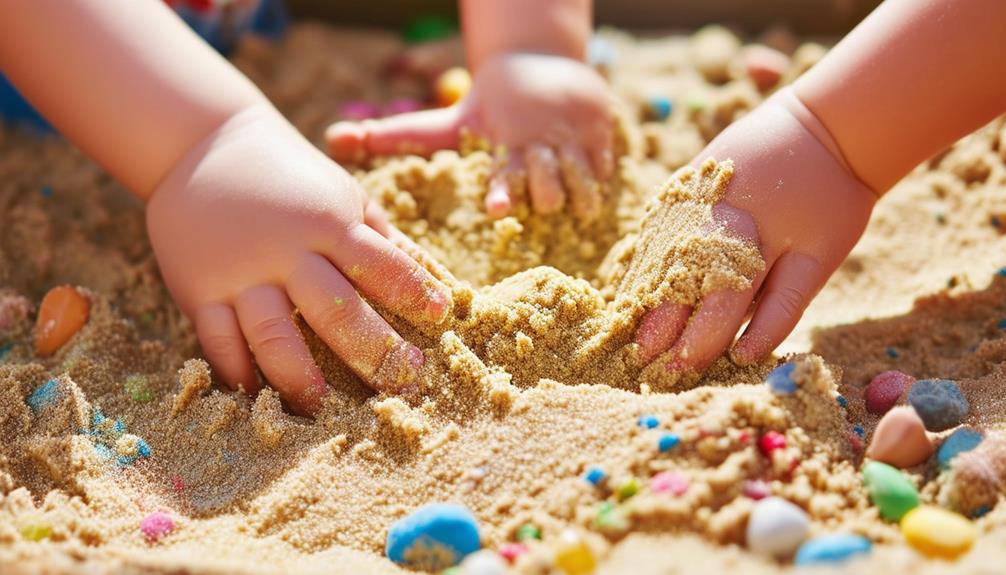
Gritty Sandbox Dough offers a unique, textured play experience by incorporating sand into the dough, making it ideal for hands-on exploration and creative fun. This variant of play dough provides a distinctive sensory activity that engages children in a novel way. The gritty texture of the sand is perfect for kids who enjoy building sandcastles, crafting beach scenes, or simply appreciating the feel of rougher materials.
Here's why you should try Gritty Sandbox Dough:
- Hands-On Exploration: The gritty texture enhances sensory development, encouraging children to explore different tactile sensations.
- Fine Motor Development: Molding and shaping this dough helps improve fine motor skills, offering an enjoyable method to practice dexterity.
- Creative Imagination: The unique texture inspires imaginative play, allowing children to create varied textured scenes and objects.
- Therapeutic Benefits: Engaging with Gritty Sandbox Dough can be calming and therapeutic, making it an excellent addition to any playtime routine.
Jell-O Playdough
Making Jell-O playdough is a delightful activity due to its simple ingredients and easy preparation. This version offers a unique texture and scent, enhancing the sensory experience for children during playtime. The vibrant colors and various Jell-O flavors allow for customization, making it even more enjoyable and engaging for kids.
Ingredients and Preparation Steps
To make Jell-O playdough, you'll need Jell-O powder, flour, salt, cream of tartar, water, and vegetable oil. Follow these steps for a successful result:
- Combine Dry Ingredients: In a bowl, mix 1 cup of flour, 2 tablespoons of salt, 2 tablespoons of cream of tartar, and one 3-ounce package of Jell-O powder.
- Add Wet Ingredients: In a separate bowl, mix 1 cup of water and 1 tablespoon of vegetable oil.
- Cook the Mixture: Gradually add the wet ingredients to the dry mixture while stirring continuously. Transfer the mixture to a saucepan and cook over medium heat, stirring constantly until it thickens and forms a dough.
- Knead the Dough: Remove the dough from the heat and let it cool slightly. Once it's cool enough to handle, knead it on a flat surface until smooth.
Unique Texture and Scent
Incorporating Jell-O powder into your playdough recipe not only adds vivid colors but also infuses the dough with delightful fruity aromas. This unique variation provides an interactive multisensory experience, combining the tender texture of playdough with the scent of your preferred Jell-O flavors. It's a fantastic way to enrich sensory play by stimulating both touch and smell.
Creating Jell-O playdough is simple. The Jell-O powder not only colors the dough but also introduces a slightly gritty texture, making the playdough feel distinct from the traditional recipe. This offers a new level of sensory stimulation for children, encouraging them to explore textural variances through touch.
Here's a quick comparison of different aspects of Jell-O playdough:
| Aspect | Traditional Playdough | Jell-O Playdough |
|---|---|---|
| Color | Basic | Vibrant |
| Scent | Neutral | Fruity |
| Texture | Smooth | Slightly Gritty |
Jell-O playdough is a fun and engaging variation on the classic recipe. By incorporating Jell-O, you're not only making the playdough more visually appealing but also providing a richer sensory experience. This innovative use of food items in sensory play activities can make playtime more enjoyable and enriching for children.
Color Variations and Benefits
Building on the delightful sensory experiences, Jell-O playdough's vibrant colors and appealing scents offer extra benefits for children's creativity and imaginative play. This colorful medium encourages kids to explore and experiment with different hues, enhancing their understanding of color blending and artistic expression.
To maximize the benefits of Jell-O playdough:
- Color Blending: Combine various Jell-O flavors to create unique shades. This hands-on activity helps children learn about color theory in a fun, interactive way.
- Enhancing Colors: Add a few drops of food coloring to diversify the palette. This allows children to create their preferred colors, expanding their creative possibilities.
- Multisensory Experience: The scent and slight taste of the Jell-O playdough engage multiple senses, including touch, sight, smell, and taste, enhancing the overall sensory experience.
- Customization: Personalize the playdough with different Jell-O flavors to make each batch unique. This keeps children engaged and stimulates their imagination.
Oatmeal Textures Play Dough
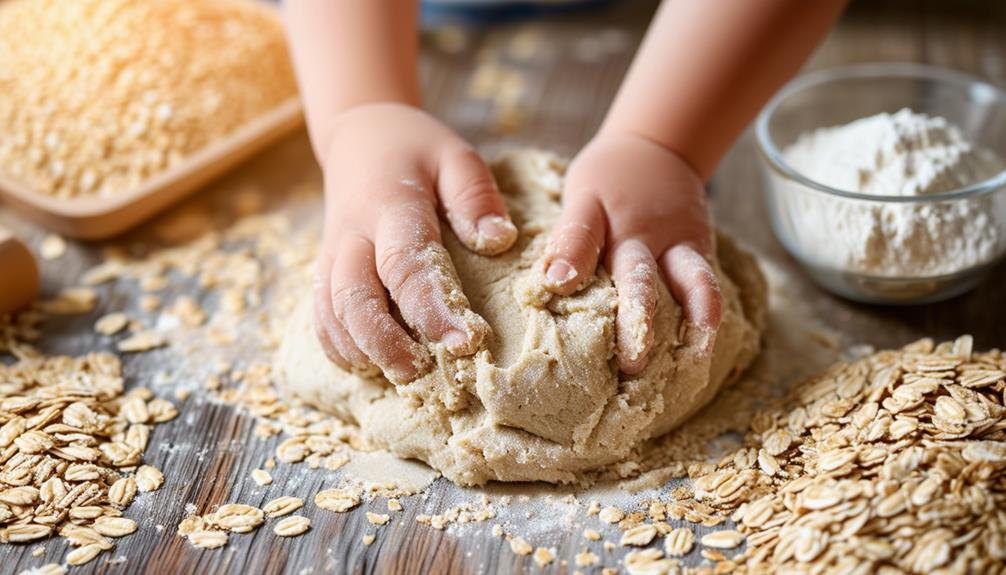
Oatmeal Textures Play Dough provides a simple recipe that incorporates a unique gritty texture for sensory play. This texture helps children enhance their fine motor skills as they mold and shape the dough. Additionally, you can customize it with various colors to make creative play more engaging.
Ingredients and Preparation
To create oatmeal sensations play dough, you'll need a few common kitchen ingredients. This recipe enhances traditional play dough with a gritty texture, providing a multi-sensory experience for children. The addition of oatmeal engages various senses, making playtime more enriching.
Here's what you'll need:
- 1 cup of flour - Serves as the base of the play dough.
- 1/2 cup of salt - Acts as a preservative and adds texture.
- 1/2 cup of oatmeal - Provides the unique, gritty texture.
- 3/4 cup of water - Combines the ingredients into a dough.
Instructions:
- Mix the flour, salt, and oatmeal in a bowl.
- Gradually add water while stirring to form a dough.
- Knead the dough until it reaches your desired consistency. If it's too sticky, add more flour; if it's too dry, add more water.
This oatmeal sensations play dough is easy to make and offers a delightful way for children to explore different textures, making it both fun and educational.
Sensory and Tactile Benefits
Oatmeal Textures Play Dough provides a unique sensory experience that significantly enhances tactile exploration and sensory development in children. By incorporating oatmeal into the play dough, you introduce a gritty texture that is perfect for little hands. This distinct texture encourages children to knead and shape the dough, offering a variety of sensations that standard play dough cannot deliver.
As children engage with the oatmeal-infused dough, they are not only having fun but also developing essential fine motor skills. The activity of squishing, rolling, and shaping the dough strengthens the small muscles in their hands and fingers, which are crucial for tasks such as writing and buttoning clothes. This hands-on play promotes dexterity and coordination, making it an excellent tool for early childhood development.
Moreover, the combination of play dough and oatmeal creates a multi-sensory experience. The visual appeal, unique tactile sensation, and subtle scent of oatmeal engage multiple senses simultaneously. This holistic sensory play supports cognitive growth and helps children better understand their environment. By incorporating Oatmeal Textures Play Dough into playtime, you provide a rich, developmental experience that is both educational and enjoyable.
Creative Play Ideas
Children's creativity can soar when they use Oatmeal Textures Play Dough in imaginative play activities. This unique play dough offers a gritty texture that stimulates the senses and encourages creative discovery. By adding oatmeal to your recipe, you're providing a distinct sensory experience that's both engaging and enjoyable. Here are some creative play ideas to get you started:
- Nature Creations: Encourage your child to create textured shapes inspired by nature, like leaves, rocks, or tree bark. This will help them appreciate natural textures and patterns.
- Storytelling Scenes: Use the oatmeal play dough to build characters and settings for storytelling. This can enrich their narrative skills and spark imaginative thinking.
- Textured Stamps: Create simple stamps using household items like bottle caps or forks. Press them into the play dough to make unique patterns and designs, enhancing fine motor skills.
- Sensory Discovery: Let your child explore the different sensory sensations by squishing, rolling, and molding the play dough. This hands-on activity is excellent for developing fine motor skills.
Oatmeal Textures Play Dough is easy to make and can be customized with diverse colors to add even more enjoyment to your child's playtime.
Aromatherapy Play Dough
Aromatherapy play dough combines the tactile enjoyment of traditional play dough with the calming benefits of essential oils. By incorporating essential oils like lavender, peppermint, and citrus, you can enhance your child's sensory experience. This play dough not only offers hands-on exploration but also introduces the soothing and stimulating properties of aromatherapy.
Imagine your child playing with lavender-scented dough as they mold and shape it. The lavender essential oil promotes calmness and relaxation, helping to ease any anxiety or restlessness. Peppermint oil, on the other hand, can invigorate and improve focus, making playtime both enjoyable and beneficial for concentration. Citrus scents like lemon or orange add a rejuvenating and uplifting aroma, perfect for brightening moods and encouraging positive energy.
Creating aromatherapy play dough is a holistic approach to sensory play. You're not just providing a tool for creative expression; you're also supporting your child's emotional well-being. Different essential oils can be swapped in and out to tailor the experience to your child's needs, making it a versatile addition to any playtime routine. So, grab some essential oils and start mixing for a multi-sensory adventure!
Funfetti Play Dough
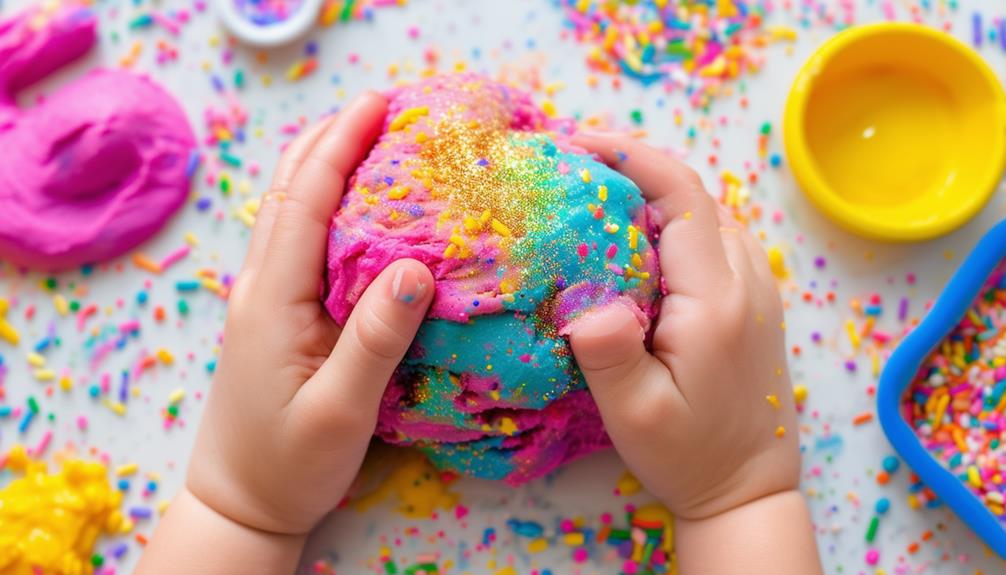
After exploring the calming and invigorating benefits of aromatherapy, let's add a burst of color and texture to playtime with Funfetti play dough. This vibrant variation is sure to captivate children with its colorful sprinkles and unique tactile sensation. The sprinkles not only enhance the visual appeal but also provide a fun sensory experience that encourages creativity and imaginative play.
To create your own Funfetti play dough, you'll need:
- Basic play dough ingredients: Flour, water, salt, cream of tartar, and vegetable oil.
- Food coloring: Choose your favorite colors to dye the dough.
- Sprinkles: Opt for colorful, nonpareil sprinkles for the best visual effect.
- Mixing tools: Bowls, spoons, and your hands.
Start by preparing a batch of basic play dough, then mix in your chosen food coloring. Once the dough is evenly colored, fold in the sprinkles. The sprinkles will add a delightful crunch and pop of color, making the play dough even more engaging.
Children can enjoy shaping and designing with this vibrant and textured Funfetti play dough, fostering their creativity and fine motor skills. Plus, you can easily customize it with different colors and types of sprinkles for endless fun!




